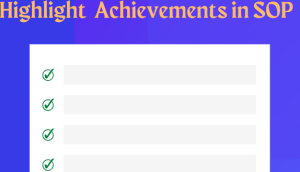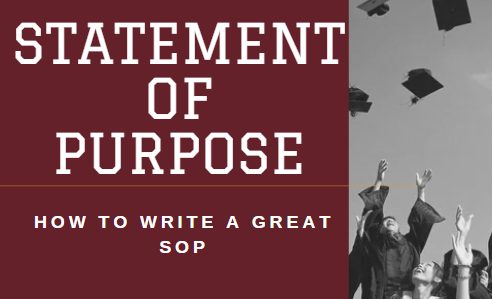Writing a statement of purpose is a hurdle many students applying for graduate programs or scholarships must scale through.
For many applicants, crafting a compelling statement of purpose can be the most challenging part of the application process. Students spend a lot of effort, time, and resources in drafting a compelling statement of purpose. This is because the success of your application rests on it.
A statement of purpose is a concise and well-structured document that allows you to articulate your goals, achievements, and motivations.
Writing a great statement of purpose is essential to make a positive impression on the admissions committee.
The following process will help applicants craft a compelling statement of purpose:
Understand the Purpose of the Statement of Purpose
Before you write your SOP, it’s crucial to understand its purpose. The statement of purpose serves as a bridge between your past experiences and your future goals. It allows you to show your qualifications, passion, and suitability for the program you are applying for.
Admissions committees use your SOP to evaluate your communication skills, your alignment with their organization’s values and mission, and your overall fit for the position or program.
Understanding the purpose of a Statement of Purpose (SOP) means recognizing that it is a crucial component of the admission process, where applicants can sell themselves to the admission committee.
With this in mind, as an applicant, do the following:
Introducing Yourself – Introduce yourself to the selection committee or potential by showcasing your personality, experiences, and qualifications beyond what you have in your resume or transcripts.
Explaining Your Motivation – Explain why you are interested in the specific program, position, or opportunity. Highlight the alignment between your goals and the goals of the institution or organization.
Show you are a Good Fit – Demonstrate that you are a good fit for the program by discussing how your skills, experiences, achievements, and background match the program’s requirements.
Showcasing Your Communication Skills – As an applicant, understand that an SOP is an opportunity to demonstrate your ability to communicate in writing. It should be well-structured, free of errors, and engaging to read. Strong communication skills are often highly valued in both academic and professional settings.
Remember to carefully read the requirements of the institution to which you are applying and tailor your SOP to meet them.
Research the Institution
One key to writing an outstanding SOP is showing your genuine interest in the institution or company to which you’re applying.

Do thorough research to understand their values, mission, and what they’re looking for in candidates. Show that you’ve taken the time to learn about their programs, faculty, or products, and explain how you align with their vision.
Admissions committees look for candidates who are a good fit for their programs, and a well-researched SOP demonstrates your genuine interest and commitment.
Here are steps to help you research the institution effectively:
Start Early – Begin your research much earlier before writing your SOP. The more time you have to gather information, the better.
Explore the Institution’s Website – An institution’s website contains a treasure trove of valuable information about the program and school you want to apply to. Visit the official website of the institution and thoroughly explore the department or program you are interested in. Some valuable information you can discover on an institution’s website includes:
- The programs overview
- The institution’s mission and values
- Admission requirement
Read Faculty member Profiles – Most institutions require post-graduate candidates to identify their faculty members whose research interests align with their own.
Identify Research Publications – Find out and mention in your SOP some notable publications and research projects associated with the institution.
Connect with the Faculty – Connecting with the faculty of the institution you wish to apply to for some clarifications is a good way to introduce yourself.
Effective research will help you write a compelling SOP that stands out and makes a good impression on the admissions committee.
Begin with a Strong Opening
Your opening paragraph should grab the reader’s attention and clearly state your purpose. Use a compelling anecdote, a quote, or a personal story to create an engaging introduction. Your opening should convey your enthusiasm and set the tone for the rest of the statement.

Here are some tips on how a candidate should begin with a strong opening in an SOP:
Start with a compelling hook – Begin your SOP with a captivating and relevant anecdote, quote, question, or a thought-provoking statement that grabs the reader’s attention. This can be a personal experience, a significant moment in your life, or a current event related to your field of study. The goal is to make the reader want to keep reading. Below is an example of a compelling hook in an SOP:
Here is a sample of a compelling hook in a Statement of Purpose:
“In a world where data is the new currency, I am on a relentless quest to unlock its secrets, harness its power, and drive innovation. The day I stumbled upon a data science project that predicted the outcome of a global health crisis with astounding accuracy, I knew my purpose was clear: to become a data scientist who not only understands the numbers but uses them to change lives. My journey into the realm of data analytics has been one marked by curiosity, determination, and a burning desire to make a meaningful impact on the world.”
This example shows the candidate’s passion for data science, alludes to a specific inspiring moment, and sets the stage for their academic and career goals. It creates a sense of intrigue and enthusiasm, encouraging the admissions committee to continue reading to learn more about the candidate’s experiences and aspirations.
Express your passion and enthusiasm – Clearly convey your genuine enthusiasm for the program and your chosen field of study. Share what inspires you and what you hope to achieve. Admissions committees are looking for candidates who are genuinely passionate about their academic and career goals.
Below is an example of a paragraph in a candidate’s Statement of Purpose that expresses passion and enthusiasm:
“From the very first time I delved into the world of environmental science, I felt an electrifying sense of purpose. The beauty of our planet and the urgency of its challenges have been a constant source of inspiration. I can vividly recall the moment when I participated in a field study, collecting soil samples in a lush rainforest, and the experience was nothing short of transformative. The earth’s delicate ecosystems and the threats they face ignited a passionate fire within me, a fire that has driven me to pursue a career dedicated to environmental conservation and sustainable practices. I am not merely seeking a graduate program; I am seeking a platform to harness my passion, refine my knowledge, and contribute meaningfully to the preservation of our planet for future generations.”
In this paragraph, the candidate conveys their deep passion for environmental science, vividly describing a transformative experience that fueled their enthusiasm. They also emphasize their commitment to making a meaningful impact and the role the graduate program will play in achieving their goals. This kind of passionate and enthusiastic tone can engage the admissions committee and make a strong impression.
Showcase your unique qualities – Highlight what makes you a unique and valuable candidate for the program. This could include your unique background, skills, experiences, or perspectives that will contribute to the diversity and vibrancy of the academic community.
Remember that the admission committee receives tens of thousands of applications, and you should make a strong first impression to stand a chance of being considered.
Here’s an example of a paragraph in a candidate’s Statement of Purpose that showcases their unique qualities:
“What sets me apart as a candidate is my eclectic background and a multifaceted approach to problem-solving. My undergraduate degree in sociology not only provided me with a strong foundation in understanding human behavior and society, but also instilled in me a deep appreciation for diversity and the nuances of different cultures. Later, during my work as a research assistant, I collaborated with a team to investigate the impact of urban planning on social cohesion in rapidly growing cities. This experience exposed me to the intersection of social sciences and urban planning, and I realized that the most pressing issues of our time often require interdisciplinary solutions. I thrive in this interdisciplinary space, where I can draw from my diverse academic background to connect seemingly unrelated dots and propose innovative solutions. My passion for bridging these gaps has led me to your program, which is renowned for its commitment to interdisciplinary research and its collaborative spirit, and I am excited to contribute my unique perspective to this dynamic community.”
In this paragraph, the candidate highlights their unique background in sociology, their experience in interdisciplinary research, and their ability to connect various disciplines to address complex issues.
They also express their alignment with the program’s values and their eagerness to contribute their distinctive perspective to the academic community. This showcases the candidate’s unique qualities and what they can bring to the program.
Highlight Your Achievements
The body of your SOP should showcase your accomplishments, experiences, and skills that make you a strong candidate. Provide specific examples to support your claims, and use action-oriented language.

Highlighting achievements in a Statement of Purpose (SOP) is essential to showcase your qualifications and make a strong case for your candidacy.
Here is how to showcase your achievements in your SOP:
Be Specific – Instead of making broad claims, provide concrete examples of your achievements.
Prioritize Relevant Achievements – Focus on achievements that are directly related to the program or position you are applying for. Tailor your examples to match the specific requirements and expectations of the institution.
Connect Achievements to Goals – Demonstrate how your past achievements have prepared you for the program you’re applying for
Whether you’re discussing your academic achievements, professional experiences, or personal growth, focus on the relevant aspects that show your suitability for the position or program.
By effectively highlighting your achievements, you can make a compelling case for your candidacy and increase your chances of being selected.
Clarify Your Goals
Discuss your short-term and long-term goals. Explain how the program you’re applying for fits into your career plan.
Be specific about what you hope to achieve and how this opportunity will help you get there. Demonstrating a clear vision for your future shows that you’ve thought carefully about your decision.
To clarify your goals effectively in your SOP, follow these steps:
State your Goals – Candidates should clearly identify what they hope to achieve by participating in this program. Think about your long-term career goals and how the program will help you reach them.
Discuss Your Plan to Achieve your Goal – Describe how you plan to leverage the program to reach your goals. What courses, resources, or opportunities in the program are essential for your success? Discuss any research topic or projects you want to undertake.
Show Passion and Commitment
Admissions committees are not just looking for qualifications; they want individuals who are genuinely passionate about their field or industry.
Express your enthusiasm for the subject or the role and explain why you are committed to pursuing it. Share personal anecdotes or experiences that illustrate your dedication.
A candidate can effectively show their passion and commitment in their SOP by doing the following:
Tell a Personal Story – Start your SOP with a personal anecdote or experience that ignited your passion for the subject. Share a relevant story that shows your emotional connection to the field.
Be Specific and Genuine – Be specific about why you are passionate about the subject. Avoid vague or generic statements. Explain what aspects of the field excite you and why.
Share Relevant Experiences – Discuss any relevant academic, research, work, or volunteer experiences that have shaped your passion and commitment. Highlight any challenges you’ve overcome in pursuit of your goals.
Discuss Your Motivation – Explain why you are motivated to pursue this specific program at the particular university. Tell the admission committee the unique aspects of the program or faculty that align with your passion and career goals.
Remember that admission committees are looking for candidates who are not only academically qualified, but who have the passion and commitment to go through with the program.
Proofread and Edit
An SOP with spelling and grammatical errors will leave a negative impression. Carefully proofread your statement of purpose to eliminate any mistakes.
Additionally, consider seeking feedback from professors, colleagues, or friends to ensure your SOP is polished and error-free.

Proofreading and editing a Statement of Purpose (SOP) is crucial to ensure it effectively conveys your goals, experiences, and qualifications to the admissions committee.
Follow these steps to proofread and edit your SOP:
Proofread multiple times – Going through your SOP several times will give you a fresh perspective each time around. You can do this by taking several breaks while reviewing.
Check for clarity and conciseness – Ensure that your writing is clear and concise. Remove any unnecessary words or sentences that do not add value to your narrative. Aim for clarity in your expression.
Structure and organization – Check if your SOP has a logical and coherent structure. It should have an introduction, body paragraphs, and a conclusion. Each paragraph should transition smoothly to the next.
Grammar and punctuation – Carefully review your SOP for grammatical errors, typos, and punctuation mistakes. Pay attention to subject-verb agreement, verb tense consistency, and correct word usage. You can use online tools to check common mistakes and errors.
Avoid repetition – Eliminate redundancy in your writing. Make sure you’re not repeating the same information or ideas.
A well-edited and error-free SOP can significantly improve your chances of being accepted.
Follow Formatting Guidelines
Some institutions have specific formatting guidelines or requirements. Always check the program’s website or application instructions for any specific formatting guidelines and follow them closely.
Adherence to formatting guidelines is crucial. Ensure that your SOP is formatted in line with the requirements provided by the institution.
Formatting guidelines include font size, margins, line spacing, and any other specific instructions. A well-formatted document reflects your attention to detail.
In the absence of specific guidelines to follow, use the following formatting tips when writing a Statement of Purpose:
Use a standard font and size – Choose a readable and professional font such as Times New Roman, Arial, or Calibri, and use a font size between 10 and 12 points. Consistency is key; stick to one font and size throughout your document.
Set page margins – Set one-inch margins on all sides of your document. This creates a clean and well-organized appearance.
Double-spacing – Use double spacing throughout the document. This includes between paragraphs and sections. Double spacing makes your SOP easier to read and provides space for reviewers to make comments.
Paragraph and section structure – Organize your SOP into paragraphs and sections with clear headings. Each section should be clearly labeled, making it easy for the reader to navigate your document. Common sections include an introduction, academic background, research or work experience, future goals, and a conclusion.
Alignment – Ensure that your text is left-aligned or justified, but avoid using centered or right-aligned text for the main body of the SOP. Left alignment is the standard for professional documents.
Indentation – Use an indentation at the beginning of each paragraph (typically half an inch) to make the text visually structured.
Length – Follow any length requirements provided by the institution or program. If there are no specific guidelines, aim for a concise and focused statement that is typically one to two pages in length.
Heading and contact information – Include your name, contact information (email and phone number), and the program you are applying to at the top of the document. You can format this information in a simple and professional manner.
File format – Save your SOP in a common and universally readable format such as PDF to preserve formatting when sharing it electronically.
Formatting your Statement of Purpose will make it easy to read, visually appealing, and professional.
Get Feedback
It’s always a good idea to have someone else review your SOP. Fresh eyes can catch errors, provide constructive feedback, and help you refine your statement further.
Here’s how a candidate can get feedback on their SOP:
Reach out to mentors and professors – Seek feedback from mentors, professors, or advisors who are experienced in your field of interest. They can provide valuable insights, correct technical details, and offer guidance on what admission committees are looking for in a successful SOP.
Use university or program resources – Many universities and graduate programs offer workshops, writing centers, or advisors who specialize in helping students craft strong SOPs. Take advantage of these resources.
Join online forums and communities – There are online forums where candidates share their SOPs and receive feedback from other applicants and current students. Keep in mind that online feedback may vary in quality, so consider the source and use it as a reference rather than the sole source of guidance.
Consult professional SOP editors – If you’re willing to invest in your application, you can hire a professional editor or a proofreading service that specializes in academic and admissions documents. They can provide detailed feedback and help you polish your SOP.
Peer review – Share your SOP with friends, colleagues, or peers who can provide a fresh perspective. They may offer insights into clarity, coherence, and general readability.
Use university alumni networks – If you have access to an alumni network related to the program you’re applying to, consider connecting with alumni who have successfully gone through the application process. They can provide valuable tips and feedback.
Admissions office or program coordinators – Some institutions or programs may offer the option to request feedback from admissions officers or program coordinators. It’s worth inquiring if this service is available.
Seeking feedback from different sources will give you an insight into some things necessary to craft a compelling SOP.
Statement of Purpose Samples
A well-crafted Statement of Purpose (SOP) can greatly influence admission committees. Here are five different examples of effective SOPs for various academic disciplines and purposes:
SOP Sample 1
Sample SOP for a Master’s in Computer Science:
“I am passionate about computer science and have been actively involved in software development projects since my undergraduate years.
My desire to pursue a Master’s in Computer Science at [University Name] is fueled by my dedication to advancing artificial intelligence research. During my internship at [Company Name], I developed a deep learning model that improved speech recognition accuracy by 15%.
This project ignited my passion for AI, and I am eager to contribute to cutting-edge research at [University Name]. With my strong foundation in programming, I am confident in my ability to excel in the program and make meaningful contributions to the department.”
SOP Sample 2
Sample SOP for an MBA Program:
“With over five years of experience in marketing and strategy development at [Company Name], I am excited to take my career to the next level by pursuing an MBA at [Business School Name].
My experience has equipped me with valuable insights into business operations, and I am eager to build a solid foundation in finance and leadership to complement my skills.
[Business School Name] stands out for its renowned faculty and extensive alumni network, which I believe will provide an invaluable platform to grow as a business leader. I look forward to contributing my unique industry perspective to class discussions and collaborating with fellow students.”
SOP Sample 3
Sample SOP for a Ph.D. in Psychology:
“My journey in psychology began with a profound fascination for human behavior. Over the course of my Master’s in Psychology at [Previous University], I conducted groundbreaking research on the neurological basis of addiction, which was published in [Reputable Journal].
Now, I am committed to delving deeper into this field through a Ph.D. program at [University Name]. I am inspired by the work of Dr. [Professor’s Name], whose research on cognitive neuroscience aligns perfectly with my interests.
I am confident that the resources and mentorship at [University Name] will enable me to make significant contributions to the field of addiction psychology.”
SOP Sample 4
Sample SOP for a Public Health MPH Program:
“Growing up in a community with limited access to healthcare, I have always been committed to addressing health disparities. My experiences volunteering with [Nonprofit Organization] have reinforced my belief in the power of public health interventions.
Pursuing a Master’s in Public Health at [University Name] is the next step in my journey to make a meaningful impact. The university’s emphasis on community-based research and its collaborations with organizations like [Partner Organization] resonate with my goals.
I am eager to leverage the knowledge and skills gained at [University Name] to advocate for healthier communities and improve healthcare access for underserved populations.”
SOP Sample 5
Sample SOP for an Art History Graduate Program:
“As a lifelong art enthusiast, my fascination with the intersections of art, culture, and history has driven me to explore art history in-depth. The graduate program at [University Name] is a perfect fit for my academic pursuits.
My undergraduate research on Renaissance art, which received accolades from professors, reflects my dedication to the field. I am particularly drawn to the comprehensive curriculum and museum partnerships at [University Name], which will enable me to engage with art in both academic and practical contexts.
I am excited to contribute my unique perspective and engage in thought-provoking discussions with my peers and professors.”
Finally, on How to Write a Statement of Purpose
Writing a great statement of purpose requires careful planning, research, and effective communication. It’s your opportunity to convince the admissions committee that you are the right fit for their program or organization.
By following these guidelines and putting in the effort to create a well-crafted SOP, you can increase your chances of success in your academic and professional pursuits.
Remember that a strong SOP should not only highlight your qualifications and achievements, but also show your genuine passion for the field and your fit with the specific program and institution you’re applying to. Each SOP should be tailored to the program’s unique strengths and your personal aspirations.
